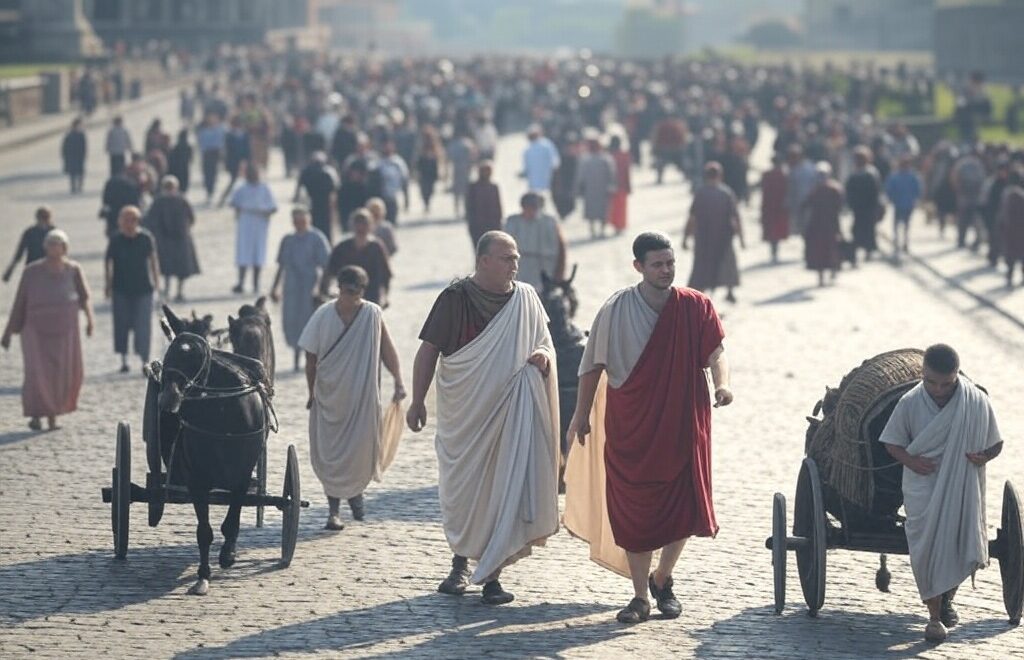Bad Traffic In Ancient Rome ?
Traffic in Ancient Rome
Overview: Ancient Rome, at its height, had a population possibly exceeding one million residents. This large urban center faced challenges in managing the flow of carts, wagons, and pedestrians on narrow streets, prompting early forms of traffic regulation and safety measures. Below is a concise, well-researched overview of how the ancient Romans experienced and managed traffic and traffic safety in the city of Rome.
1. The Nature of Traffic in Ancient Rome
1.1 Rome as a Bustling Metropolis
By the 1st century BCE, Rome had grown into a vast city with a dense population. A city of that size naturally saw a great deal of activity:
- Commerce and Trade: Goods flowed into Rome from all over the empire, requiring wagons and carts to transport merchandise.
- Urban Mobility: People traversed the streets on foot or by horse-drawn vehicles, sedan chairs, or even on horseback.
- Social and Civic Events: Major festivals, processions, and public ceremonies often caused large crowds and restricted normal traffic.
Although ancient Rome lacked modern automobiles, the movement of people and horse-drawn wagons often led to congestion reminiscent of today’s traffic jams.
1.2 Road Infrastructure
Rome’s famed road network extended throughout the empire, but the city streets themselves could be narrow and winding:
- Paved Streets: Many major roads in Rome were paved with stone slabs, enabling relatively smoother travel compared to dirt surfaces.
- Sidewalks and Drainage: In higher-status areas, elevated sidewalks and drainage systems helped keep pedestrians separate from carts.
These infrastructural innovations eased travel somewhat, but population growth often outstripped the city’s design, leading to high levels of congestion near markets, the Forum, and other busy districts.
2. Legal Restrictions and Attempts to Manage Traffic
2.1 Julius Caesar’s Traffic Regulations
One of the earliest known legal measures to address overcrowded streets came under Julius Caesar in the 1st century BCE:
- Time Restrictions: Heavy wagons were prohibited from entering the city center during daylight hours, thereby reducing congestion for much of the day.
- Exceptions: Certain vehicles, such as those belonging to high-ranking officials or the Vestal Virgins, were granted exemptions.
Caesar’s approach was designed to ease daytime traffic and improve mobility for ordinary citizens.
2.2 Other Imperial Era Edicts
Later emperors refined Caesar’s restrictions:
- Limiting the Number of Carts: Authorities often restricted pack animals and wagons during peak hours, reducing noise and crowding.
- Road Maintenance Laws: Aediles (magistrates in charge of public amenities) repaired roads and enforced weight limits on carts.
These measures illustrate official recognition of traffic congestion as a public safety issue.
3. Early Approaches to Traffic Safety
3.1 The Threats of Ancient Traffic
Even with slower vehicles, accidents were common:
- Collisions: Narrow streets increased the likelihood of carts colliding with each other or with pedestrians.
- Pedestrian Injuries: Minimal street lighting and a lack of standardized lanes exposed pedestrians to dangers from horses or wagons.
- Road Hazards: Uneven pavement and obstructed roads led to trips, falls, and vehicle overturns.
3.2 Safety Measures
Although there were no traffic lights or modern speed limits, several practices enhanced safety:
- Raised Sidewalks: Pedestrians were protected from wheels and hooves, and stepping stones provided a rudimentary crosswalk system.
- Dedicated Routes and Times: Restricting certain vehicles to night deliveries was an early form of “road rationing,” reducing daytime crowding.
- Use of Milestones: Along roads outside the city, milestones aided navigation and logistics, indirectly helping to prevent congestion.
- Oversight by Aediles: Aediles could fine owners of carts in disrepair or vehicles overloaded beyond safe capacity.
4. Social and Cultural Factors Affecting Traffic Management
Several broader factors shaped how Romans managed traffic:
- Status and Class: Elite Romans often traveled by litter (a carried sedan chair). This method could bypass some congestion but also create bottlenecks if accompanied by large retinues.
- Public Events: Major festivals, triumphs, and religious observances temporarily banned non-essential traffic in certain areas, alleviating some congestion.
- Nighttime Noise and Curfews: Many authors, such as Pliny the Younger, complained about carts rumbling through the streets at night, highlighting that shifting traffic to off-hours created new problems.
5. Evaluating Ancient Rome’s Traffic Measures
Rome’s strategies, while rudimentary by modern standards, demonstrate a clear effort to deal with a large city’s challenges:
- Congestion Recognition: Time-based vehicle restrictions showed that Roman leadership saw traffic as an economic and social issue.
- Basic Safety Infrastructure: Sidewalks, stepping stones, and penalties for poorly maintained carts offered early standards for public safety.
- Centralized Regulation: The existence of officials like aediles indicates Rome’s commitment to organized urban management.
- Balancing Commerce and Comfort: Restricting heavy traffic to off-peak hours helped maintain daytime flow but led to nighttime noise and occasional accidents.
Conclusion
Although ancient Romans did not face motorized vehicles or the vast fleet of cars we see today, the city’s dense population and many wagons, carts, and animals created notable congestion. Time-based restrictions, raised sidewalks, and continuous road maintenance all emerged as ways to manage the challenges of a bustling metropolis. These measures, though simple, represent a surprisingly forward-thinking approach to urban mobility and public safety—a testament to Rome’s enduring legacy of engineering and governance.

